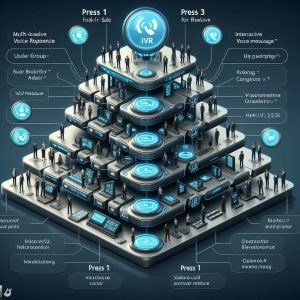Interactive voice response (IVR) systems have become a vital productivity tool helping organizations efficiently route and manage inbound calls. While single-level IVRs offer basic functionality, businesses are increasingly adopting more advanced multi-level IVR solutions to transform customer and employee experiences.
This guide will explain what multi-level IVRs are, their benefits, ideal use cases, and best practices for maximizing value. Read on to learn how modern multi-level IVRs can streamline communications, improve customer satisfaction, and reduce costs.
What is Multi-Level IVR?
A multi-level IVR is an automated phone tree system that uses voice prompts and menu options to guide callers through multiple levels of routing and self-service. Callers navigate the IVR by responding to prompts using voice commands or their phone’s keypad.
In a single-level IVR, the caller hears a simple greeting message followed by a single menu layer. Multi-level IVRs expand on this by chaining together two or more layers ofprompts and menu choices.
This added hierarchy provides more refined call routing, self-service capabilities, and contextual personalization for superior customer and employee experiences.

How Multi-Level IVRs Work
When a call comes into a multi-level IVR system, the automated phone tree experience typically follows this general flow:
- Welcome greeting identifies the business and optional opening hours message.
- First menu layer collects information like language preference or request type.
- Second layer matches caller selection to appropriate department or provides self-service options.
- Additional layers continue segmentation and personalization based on earlier inputs.
- Caller reaches relevant final destination such as agent, voicemail, or automated service.
6.sgiving customers just the right information or department saves time and frustration.
By capturing the caller’s purpose early on, subsequent menu layers can provide tailored options and self-service aligned to their specific needs.
The Benefits of Multi-Level IVRs
Intelligent call routing and tailored self-service add up to big benefits for both customers and businesses.
Time Savings
Multi-level IVRs pre-qualify callers so agents can immediately focus on their actual needs instead of repetitive screening. This reduces handle times and costs.
Improved Self-Service
Guided menus make it easy for customers to quickly get information or conduct transactions without needing to wait for an agent.
More Accurate Call Routing
Capturing context via IVR inputs routes callers to the optimal department, improving first-call resolution.
Increased Customer Satisfaction
Personalizing options to caller needs cuts down on fruitless menu prompts, reducing frustration.
24/7 Availability
Full automation provides helpful self-service options around the clock without added staffing.
Enhanced Data Collection
Aggregated IVR usage data provides insights to identify opportunities and guide improvements.
The right multi-level IVR delivers a smoother, more tailored experience driving cost savings plus customer and employee satisfaction.

Use Cases for Multi-Level IVRs
While suitable for many businesses, multi-level IVRs excel in these common scenarios:
- Large companies – Route calls across multiple departments, sites, or brands.
- Diverse product/service lines – Provide tailored options for different audience segments.
- High call volumes – Deflect calls from live agents using extensive self-service.
- Global organizations – Localize language and menu options across geographies.
- Healthcare – Guide patients based on symptoms or direct to prescription refills.
- Finance – Enable secure PIN-based account access and transactions.
- Retail – Drive sales by personalizing promotions based on customer data.
Prioritizing use cases with clear ROI will maximize benefits.
Setting Up a Multi-Level IVR
Modern IVR solutions make creating multi-level systems quite manageable:
- Cloud platforms – Leading cloud contact center providers like Five9, RingCentral, and Talkdesk simplify building IVRs with easy drag-and-drop editors.
- On-premises – Many PBXs and VoIP platforms include IVR management tools. For legacy systems, IVR add-on solutions are available.
- Hybrid – Integrate legacy on-premises IVR with modern cloud contact center capabilities for maximum investment protection.
- APIs – IVR vendors expose APIs to drive integrations with backend systems like CRMs, databases, and ERPs.
- BYOD – Use an IVR development platform to build your own custom IVR applications.
With the right approach, flexible multi-level IVRs can be deployed quickly across diverse environments.

Best Practices for Multi-Level IVR Success
Follow these tips to maximize value from your investment:
- Map the journey – Diagram the optimal IVR journey and dialogues from the customer perspective. Refine via user testing.
- Limit choices – Offer just 2-4 options per prompt to avoid overwhelming callers.
- Use natural language – Adjust phrasing based on how real callers describe their needs.
- Personalize prompts – Insert relevant details like account numbers to boost personalization.
- Set expectations – Be transparent on any wait times or transfer possibilities.
- Refine prompts – Analyze IVR analytics to identify poorly performing menus and prompts.
- Monitor performance – Track key metrics like containment rate to optimize the IVR.
- Update regularly – Keep the IVR in tune with new products, services, and initiatives.
Following IVR best practices ensures your multi-level solution delivers maximum benefits and return on investment.
Conclusion
Today’s IVR solutions offer powerful capabilities to create caller experiences that are swift, personalized, and satisfying. Multi-level IVRs enable businesses to capture customer contexts early in the call journey in order to provide tailored self-service options and routing. Architecting IVRs focused on natural dialogues and customer needs is critical for success. With smart implementation, multi-level IVRs can transform customer interactions to improve satisfaction while containing costs.